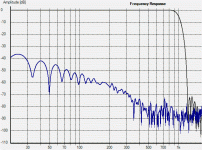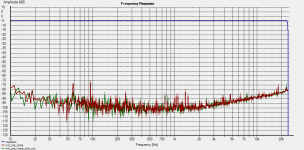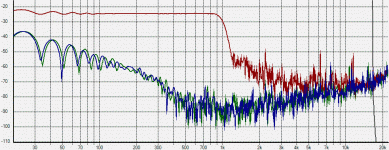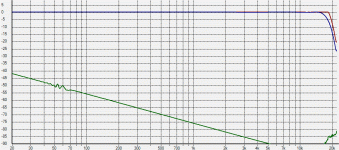DQ828: Your phase looks quite right for a 3-way.
Every crossover point with a 4th order filter, makes for a phase shift of 360 degrees. The phase response starts to change approx. 10x below and 10x higher than the attack frequency.
Normally all frequency analysers anticipates 360degrees = 0 degrees, because you have moved to the same point at the next cyclus. Your signal will actually be delayed 1 cycle, which means that the delay in mS will depend on the actual frequency.
Normally the phase shifts are not directly audible, so you should just base your choices for level of delay on each frequency area, on the impulse response. Even that looks nice allready on your graphs. How does it sound?
I hope it makes sense.
I have just this minute finished setting them up to start listening, as it is late & I am knackered I'm wont get much listening done tonight, but will report back in my build thread, in the coming days, http://www.diyaudio.com/forums/multi-way/175072-ob-project-design-started-help-requested.html.
Thanks for the reassurance, I'm not sure how you worked all of that out from the graph, I wish I new what it meant. Thanks again
David
Hey everyone,
I want to make a cable to do the Sound Card measurement
From Xonar Essence STX phono (OUT) to Blue Icicle XLR (IN)
I have a twin core shielded cable, XLR and (1) Phono connectors
looking at the Diagrams here I think I should wire as No. 17
Sound System Interconnection
I see in other places I should wire as No. 6
as the Icicle provides the 48v Phantom automaticaly (no switch) to the ECM8000,
I dont want it powering my Sound Card
Im eager to start playing with this great bit of software!
Thanks
Justin
I want to make a cable to do the Sound Card measurement
From Xonar Essence STX phono (OUT) to Blue Icicle XLR (IN)
I have a twin core shielded cable, XLR and (1) Phono connectors
looking at the Diagrams here I think I should wire as No. 17
Sound System Interconnection
I see in other places I should wire as No. 6
as the Icicle provides the 48v Phantom automaticaly (no switch) to the ECM8000,
I dont want it powering my Sound Card

Im eager to start playing with this great bit of software!
Thanks
Justin
I have tried to take some time measurements of the new speakers, so I could apply a delay for the Mid-Tweeter drivers using the MiniDSP, as expected the Mid & Tweeter appear to be aligned well enough (from my reading) but the bass driver appears to be in the next roomAn externally hosted image should be here but it was not working when we last tested it.I would say the physical horizontal distance between the MT & bass driver is about 40mm (bass behind MT). Does anyone know how to interpret these measurements.
Oh and I have no idea what the phase is trying to tell me so some help there would be greatly appreciated.
David
Since you have the MiniDSP there is no reason not to fine tune the phase handoff of your setup. The mic should be on axis and back from the speaker far enough to minimize the relative distance error between the drivers and close enough to avoid excessive multipath issues. You may want to try about 2 m back and move closer if needed.
Assuming your graph reflects this type of setup the phase can be improved for both the W-MR and the MR-TW XOs. The dotted phase curves should overlay as much a possible through the acoustic XO ranges or from about 200-450 Hz and 1.8k to 4k Hz.
Note that the W phase at the 380 Hz acoustic handoff is about 40 deg and the MR is about 180 deg. This is a 140 deg differential. If you delay the MR more relative to the W the two curves will overlay much better. For the MR-TW the phase curves are closer, but can still be improved a little. The TW needs a little less delay relative to the MR for the best match.
Your system can be setup within 10 to 20 deg throughout the XO ranges with some fine tuning of the delays.
Well, I knocked up a cable as Diagram No.17
Tip of Phono to pin 2 XLR
Case of Phono to pin 3 XLR
I havent pluged it into the soundcard but an output of another device,
the Phantom power light (Ring around the gain knob) lights up as if to say its sending 48v somewhere...
maybe I`ll try connecting pin 1 and 3 of the XLR together...
Still unsure if Im barking up the wrong tree here and Im not going to get a result either way..
Do I NEED a transformer between the phono and XLR connector?
Tip of Phono to pin 2 XLR
Case of Phono to pin 3 XLR
I havent pluged it into the soundcard but an output of another device,
the Phantom power light (Ring around the gain knob) lights up as if to say its sending 48v somewhere...
maybe I`ll try connecting pin 1 and 3 of the XLR together...
Still unsure if Im barking up the wrong tree here and Im not going to get a result either way..
Do I NEED a transformer between the phono and XLR connector?
I've been doing HF measurements with Holm using swept sine and all has been good.
I'm now trying to do LF measurements and the MLS signal seems to lack low frequency energy (it sounds like white noise). I am having trouble getting over the noise floor which is also a problem. The noise floor is tilted downward as shown in the picture. This was taken using the MLS signal but I removed the mic and muted the amps driving the speakers before I took this shot so it would show the floor. Does this look normal?
I'm now trying to do LF measurements and the MLS signal seems to lack low frequency energy (it sounds like white noise). I am having trouble getting over the noise floor which is also a problem. The noise floor is tilted downward as shown in the picture. This was taken using the MLS signal but I removed the mic and muted the amps driving the speakers before I took this shot so it would show the floor. Does this look normal?
Attachments
It doesn't look particularly normal to me, 50db is an awfully big difference between your low freq noise floor and your higher frequency noise floor!
Have you done a loop-back measurement on your soundcard? That is cable from output looped back to input? It should give a very flat response. Or is that what the plot up the top is? if so was it a sampling rate of only 2048 Hz?
Below is a plot of my noise floor almost as you have described. Blue plot is a loopback measurement. Red trace is with a Mic preamp connected via RCA cable plugged into the sound card but no mic connected. Green trace is with Mic preamp plugged in, turned on and microphone attached (just ambient background noise).
If you did take the measurement at only 2048 Hz sampling rate (to get more low frequency resolution) I'd try bumping it up to at least 16K (I used to use that with speakerworkshop). I can't select anything lower than 44.1Khz in Holm though, so I'm using one of my card's two native resolutions ie 48Khz...
edit: also the plot below is raw response, and sort of smoothing I turned on changed it quite a bit.
Tony.
Have you done a loop-back measurement on your soundcard? That is cable from output looped back to input? It should give a very flat response. Or is that what the plot up the top is? if so was it a sampling rate of only 2048 Hz?
Below is a plot of my noise floor almost as you have described. Blue plot is a loopback measurement. Red trace is with a Mic preamp connected via RCA cable plugged into the sound card but no mic connected. Green trace is with Mic preamp plugged in, turned on and microphone attached (just ambient background noise).
If you did take the measurement at only 2048 Hz sampling rate (to get more low frequency resolution) I'd try bumping it up to at least 16K (I used to use that with speakerworkshop). I can't select anything lower than 44.1Khz in Holm though, so I'm using one of my card's two native resolutions ie 48Khz...
edit: also the plot below is raw response, and sort of smoothing I turned on changed it quite a bit.
Tony.
Attachments
Last edited:
The red trace is the loopback response with the signal lowpassed at 1000Hz. The blue trace is with the input coming from the phantom power supply with no mic and amps turned off, the green trace is the same but with Holm set to lowpass the signal at 16,384Hz...although I can't see where the lowpass frequency can make much of a difference the way I have it set up at the moment. I just hope this data can show something useful.
Attachments
hmmm do you get the ~20Hz harmonics (between 20 and 100Hz) if you do a measurement with Nothing plugged into the sound card at all? It does seem like there is a wiggle there even in the loopback measurement....
Also have you done a DAC-ADC calibration with the loopback cable connected?
Is your phantom power for your mic battery operated?
I'm also wondering if there is any form of earth loop between the amp and your pc (though if the amps were turned off maybe not)...
edit: also I just lowpassed my loopback (post measurement) at 1000Hz and I get a quite different result to what you have shown, starts to roll off at 1000Hz smoothy going to nothing over the range of 1000Hz (as per the second parameter). I think something is definitely screwy.... you could try clearing all of your measurements and shutting down and restarting your pc
Tony.
Also have you done a DAC-ADC calibration with the loopback cable connected?
Is your phantom power for your mic battery operated?
I'm also wondering if there is any form of earth loop between the amp and your pc (though if the amps were turned off maybe not)...
edit: also I just lowpassed my loopback (post measurement) at 1000Hz and I get a quite different result to what you have shown, starts to roll off at 1000Hz smoothy going to nothing over the range of 1000Hz (as per the second parameter). I think something is definitely screwy.... you could try clearing all of your measurements and shutting down and restarting your pc
Tony.
Last edited:
Same with in/out removed at the soundcard.hmmm do you get the ~20Hz harmonics (between 20 and 100Hz) if you do a measurement with Nothing plugged into the sound card at all? It does seem like there is a wiggle there even in the loopback measurement....
Yes.Also have you done a DAC-ADC calibration with the loopback cable connected?
Yes. My phantom power supply/preamp is simply batteries and capacitors.Is your phantom power for your mic battery operated?
I'll just overhaul the phantom box, needed or not. I once had an issue with the joints within it.
If you are getting the same result with or without anything patched into the card then it would seem that the noise problem is with the card itself. I note that your loopback measurement is at nearly -20db, have you tried different levels for output and input? (My card is fairly sensitive to getting these right).
Have you tried RMAA Download. Audio Rightmark will only give you loopback type measurements but would be interesting to see the noise graph produced by a different program, and should show whether there is an inherent noise issue with your card itself
Also DBMandrake gave me some very useful advice (specifically for my card, an Audigy II ZS) and that was to quit all programs that might use the sound card for any reason (if you have a sound card and on board sound as well, then enable the onboard, and set it to be the default for playback and recording). Itunes was apparently a particular problem. The other one was to ensure that the sample rate you are using is one that is natively supported by your card.
I think you should concentrate on the soundcard rather than the phantom power for the moment
Tony.
Have you tried RMAA Download. Audio Rightmark will only give you loopback type measurements but would be interesting to see the noise graph produced by a different program, and should show whether there is an inherent noise issue with your card itself
Also DBMandrake gave me some very useful advice (specifically for my card, an Audigy II ZS) and that was to quit all programs that might use the sound card for any reason (if you have a sound card and on board sound as well, then enable the onboard, and set it to be the default for playback and recording). Itunes was apparently a particular problem. The other one was to ensure that the sample rate you are using is one that is natively supported by your card.
I think you should concentrate on the soundcard rather than the phantom power for the moment
Tony.
Since you have the MiniDSP there is no reason not to fine tune the phase handoff of your setup. The mic should be on axis and back from the speaker far enough to minimize the relative distance error between the drivers and close enough to avoid excessive multipath issues. You may want to try about 2 m back and move closer if needed.
Assuming your graph reflects this type of setup the phase can be improved for both the W-MR and the MR-TW XOs. The dotted phase curves should overlay as much a possible through the acoustic XO ranges or from about 200-450 Hz and 1.8k to 4k Hz.
Note that the W phase at the 380 Hz acoustic handoff is about 40 deg and the MR is about 180 deg. This is a 140 deg differential. If you delay the MR more relative to the W the two curves will overlay much better. For the MR-TW the phase curves are closer, but can still be improved a little. The TW needs a little less delay relative to the MR for the best match.
Your system can be setup within 10 to 20 deg throughout the XO ranges with some fine tuning of the delays.
Thanks for the response, I didn't realise you had posted it until today, I follow the threads through the "List Subscriptions" which usually shows me any new post in the thread I have been in but occasionally it doesn't. There is an Australian forum that does that all the time, a bit of a pain really.
I am challenged when it comes to phase response, I understand the concept (mostly) but really have trouble interpreting the charts. I will be getting back to that side of things as soon as I tidy up a couple of other projects that are taking WAY too long. the prototypes I have built still need a bit of work & I am going to give another mid a run as well.
Thanks again
David
I think you should concentrate on the soundcard
Which sounds fair.
I went out and bought a brand new sound blaster. I de-installed Holm, deleted the user directory with the cal files and saved plots, restarted the computer and opened no other program, installed Holm, calibrated via loopback with the output and recording levels on full, then took this plot with no cables connected to the card.
Attachments
Umm, it may be because I'm one of these types that never switches anything off before reconfiguring, but I can sense the risk on a case by case basis. Although I am safety conscious, I've always felt that perfectionism stifles creativity, hehe. Anyway, who wants to be switching amps on and off when playing around line level? I could have blown up a lot more.
I do think soundcards are needlessly frail. I may have to connect a buffer of some sort. I don't want a full preamp though, just a protective buffer.
I do think soundcards are needlessly frail. I may have to connect a buffer of some sort. I don't want a full preamp though, just a protective buffer.
Last edited:
You need to have a file specific to your ECM8000. i have 3 calibrated ones and the curves are all different
dave
Is something better than nothing?
david
Is something better than nothing?
I think so. I looked around and came to an intuitive guess with my cal file...a downloaded generic one that was claimed to be an average of dozens of real cal files.
Looking at my measurements, the correction just felt right...or at least a good step in the right direction. Better still, it sounded like a good step in the right direction.
I suggest you think about what you expect you should be measuring above 2kHz and look at your results, after studying the form of some correction files. You'll probably develop the feel I'm talking about.
- Home
- Design & Build
- Software Tools
- HOLMImpulse: Measurements in practice



